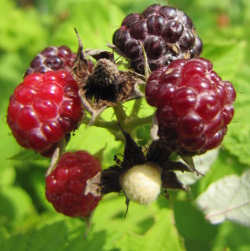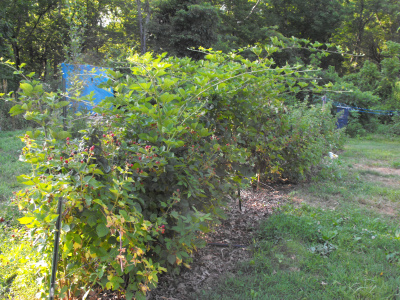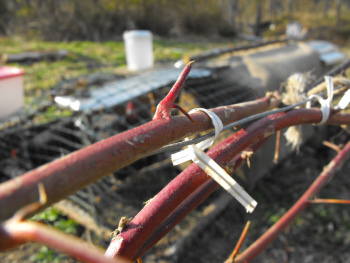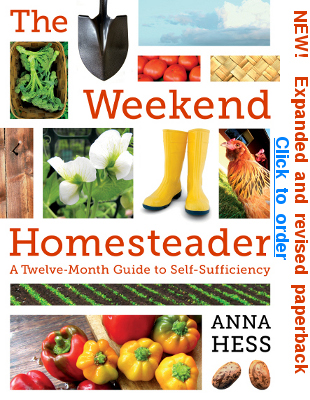
Choosing, planting, and training brambles
 There
are only two potentially complicated parts of growing blackberries and
raspberries --- variety selection and pruning. Otherwise, care is
simply a matter of annual fertilizing, mulching, and (most important)
eating all those fruits.
There
are only two potentially complicated parts of growing blackberries and
raspberries --- variety selection and pruning. Otherwise, care is
simply a matter of annual fertilizing, mulching, and (most important)
eating all those fruits.
Choosing your brambles
As I mentioned
previously, blackberries and black raspberries do better
in the south while red raspberries like areas with cooler
summers. Over large parts of the United States, you can easily
grow all three types of brambles, but your life will be a bit easier if
you begin your experiment with ones that are well suited to your
climate.
Once you decide which
type of brambles you want to grow, your next step
is to settle on which additional characteristics you're looking
for.
Thornless blackberries are easier to work with, but I've noticed
they don't seem to be as cold hardy as the thorny varieties, so
northerners should bear with thorns.
Among raspberries, you'll need to decide whether you're interested in a
spring or everbearing variety --- unlike with strawberries, I have had
very good luck with everbearing raspberries and recommend them highly.
Bramble plants tend to
be more expensive than strawberries, often
costing several dollars apiece, but you don't need to start with
many. In my garden, one everbearing raspberry plant became a
clump large enough to provide lots of fruit that fall, and by the next
spring I was able to transplant yet more new raspberries to fill up a
whole row. The third spring, I gave away gobs of raspberry
starts,
and by the fourth year after planting all of my friends stopped
answering the phone when raspberry-planting season came around.
So --- choose your variety wisely, but don't be concerned about
starting small.
Planting and training brambles
Blackberries and
raspberries have a tendency to try to take over the
world, so plan ahead when selecting their location. I find it
helpful to plant brambles in mulched rows about eighteen inches wide,
then mow anything that tries to grow beyond the mulch boundary.
Unlike most other garden plants, brambles can handle tough clay soil
and even some degree of waterlogging, so feel free to put them in that
spot where nothing else will grow.
 If
you're turning lawn or weeds into a berry patch, lay down a thick
kill mulch and plant your brambles into holes in the cardboard.
The best time to plant is in early spring, which means you'll probably
be putting in dormant, bare-rooted stock. The young brambles will
have a dead-looking cane poking up out of the roots --- the cane is
indeed dead, but the plant will send up a new cane once warm weather
rolls around. Mulch the patch well, preferably with something a
bit more carbon-rich than you used for your strawberries. (See
Weekend
Homesteader: July for more information on types of mulch, or
just use well-rotted wood chips.)
If
you're turning lawn or weeds into a berry patch, lay down a thick
kill mulch and plant your brambles into holes in the cardboard.
The best time to plant is in early spring, which means you'll probably
be putting in dormant, bare-rooted stock. The young brambles will
have a dead-looking cane poking up out of the roots --- the cane is
indeed dead, but the plant will send up a new cane once warm weather
rolls around. Mulch the patch well, preferably with something a
bit more carbon-rich than you used for your strawberries. (See
Weekend
Homesteader: July for more information on types of mulch, or
just use well-rotted wood chips.)
 Brambles don't need an extremely sturdy trellis, but it is helpful to
find a way to tie the plants so they don't bend down over the
path. I use light-weight metal fence posts about five feet apart
with two strands of thin wire running between them. Twist ties
are a simple way of attaching canes to the wire temporarily --- you'll
need to be able to unhook them when you prune out dead canes next
winter.
Brambles don't need an extremely sturdy trellis, but it is helpful to
find a way to tie the plants so they don't bend down over the
path. I use light-weight metal fence posts about five feet apart
with two strands of thin wire running between them. Twist ties
are a simple way of attaching canes to the wire temporarily --- you'll
need to be able to unhook them when you prune out dead canes next
winter.
This
week's lunchtime series is exerpted from Weekend
Homesteader: February,
which is available for 99 cents from Amazon's kindle store. The
ebook
also includes a primer on choosing and caring for a backyard flock of
chickens, information on buying in bulk, and tips for creating your own
apprenticeship. If you enjoy the book, please consider leaving me
a
review.
 This post is part of our Easy Berries lunchtime series.
Read all of the entries: This post is part of our Easy Berries lunchtime series.
Read all of the entries: |
Want more in-depth information? Browse through our books.
Or explore more posts by date or by subject.
About us: Anna Hess and Mark Hamilton spent over a decade living self-sufficiently in the mountains of Virginia before moving north to start over from scratch in the foothills of Ohio. They've experimented with permaculture, no-till gardening, trailersteading, home-based microbusinesses and much more, writing about their adventures in both blogs and books.
Want to be notified when new comments are posted on this page? Click on the RSS button after you add a comment to subscribe to the comment feed, or simply check the box beside "email replies to me" while writing your comment.

That's an excellent question, and reminds me I probably should address chill hours briefly in my chapter on fruit trees.
We're far enough north that chill hours don't seem to be a problem. You mostly hear about them when you're in the deep south.
http://agroclimate.org/tools/ChillAccum/ doesn't cover Virginia, but does have nearby states. It looks like Asheville averages 1912 chill hours per year, which is probably similar to our climate.
That said, there are multiple methods of determining chill hours --- if you use the more modern but less common method of counting only hours between 32 and 45 rather than all hours under 45, Asheville averages 958 chill hours.
All of that said, I really don't worry about chill hours (but I don't buy "low chill" varieties.) I've had best luck buying fruit plants locally, but have also had about a 60% success rate with mail order plants. The varieties I consider failures grew just fine, but came down with fungal diseases in our wet climate. Around here, disease and pest resistance are what I focus on (after taste) since I grow organically.
As always your posts are right on time. I want try again to re-establish a food forest scenario around the perimeter of our property.
In the past, I was able to root a cutting of a thornless blackberry, winter sowing style. Is there anything special that you need do to propagate wild berries for this purpose? We have an abundance of wild Southern dewberries growing in random places around the yard and I want to move them to the fence line.
Thanks.
Wild brambles are generally extremely easy to work with. I just dig them up and transplant in the winter, then mulch around them and they take over. (That's the real trick --- making sure they don't form an impenetrable thicket.)
I haven't transplanted dewberries, but since they're really just a dwarf species of blackberry, I don't think you'll have any trouble. As you dig them up, you'll probably notice that they've already tip-rooted in several places --- you can cut plants apart as desired until you only have one root mass per plant.
Good luck! It sounds like a fun project.